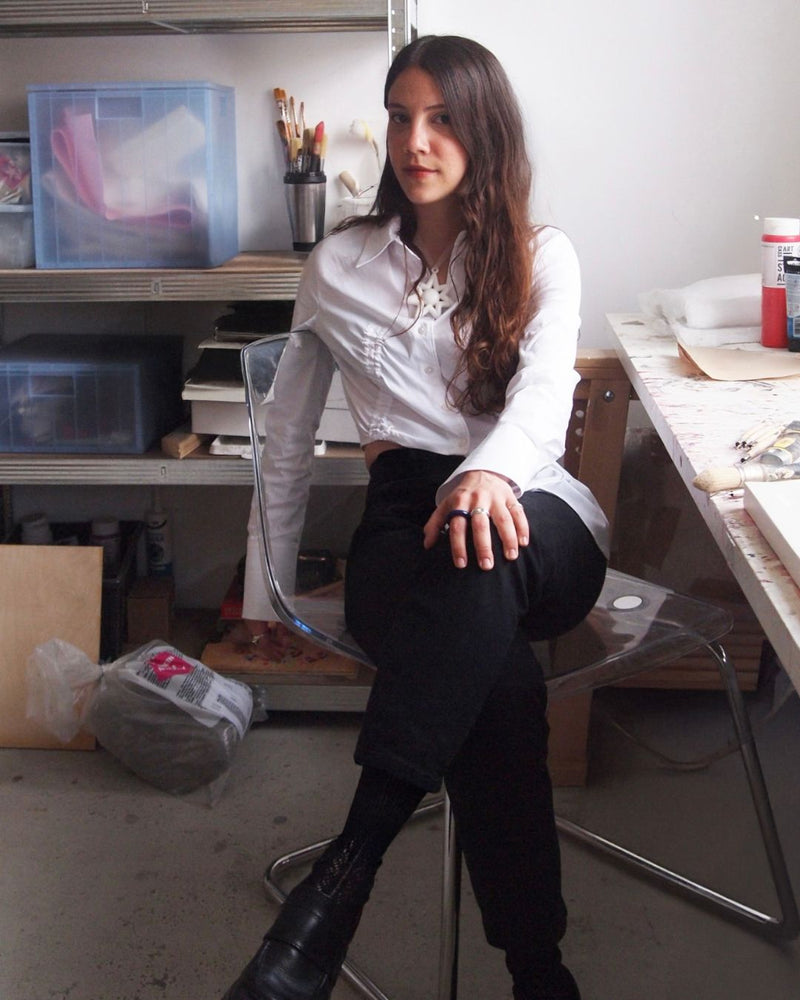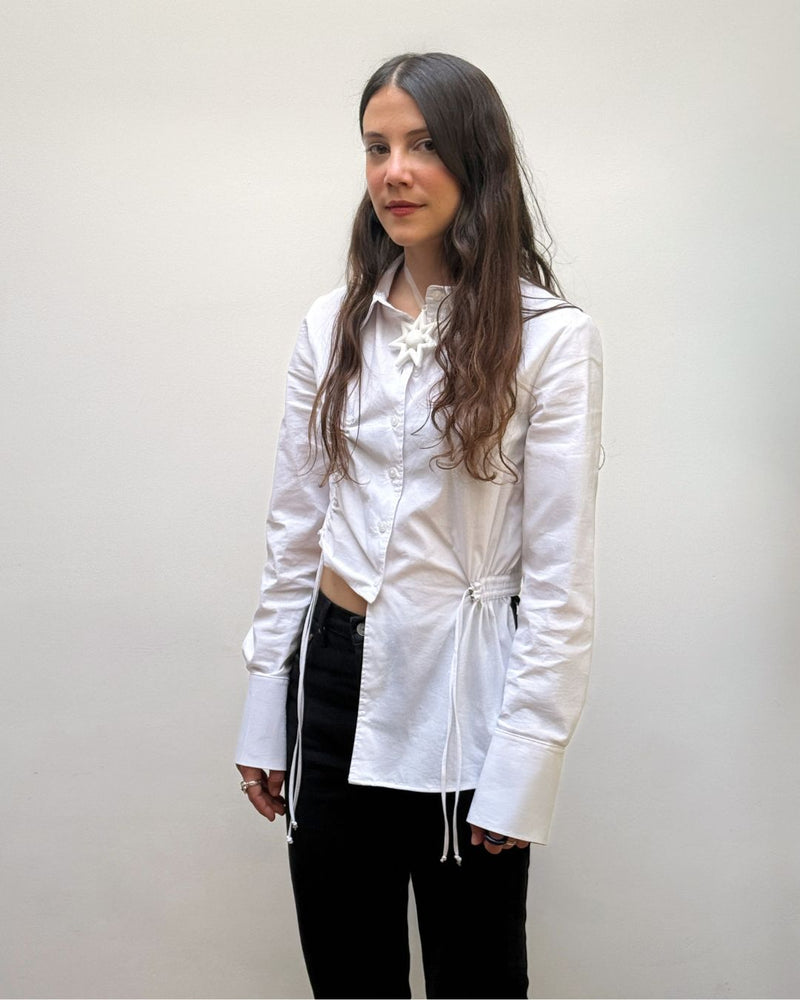“The Luster” Opens at vitruta London: A Reflection on Digital Presence and Desire
Text: Alara Demirel
From May 8–15, The Luster will take over vitruta King’s Cross in Coal Drops Yard. Curated by Display Fever, an art platform and online gallery championing accessibility in the city’s art scene while spotlighting women and queer artists from diverse international backgrounds, The Luster marks the very first exhibition at vitruta’s new UK location.
Drawing inspiration from Hito Steyerl’s seminal essay The Terror of Total Dasein: Economies of Presence, the exhibition critiques the pressure to perform constant digital presence and the polished personas we construct online. Featuring ten international artists, The Luster delves into how sleek, curated surfaces often conceal deeper emotional and political complexities — while tracing contemporary forms of longing, connection, and visibility.
Presented across vitruta’s carefully designed industrial interior with exposed brick, steel beams, and tactile surfaces—the show becomes a site-specific dialogue between material, architecture, and emotion.
Artists featured include: Faysal Altunbozar, Damaris Athene, Solanne Bernard, Paola Estrella with garments by Gabrielle Venguer, Ela Kazdal with sound by Iñaki Ramírez Romero, Lera Kelemen, Dilara Koz, Inés Miño Izquierdo, Naomi Boiko-Stapleton, and Ella Yolande.On opening night, the exhibition will feature a performance by artist Paola Estrella, alongside a DJ set byMikrosono Radio Gallery, featuring Gludo and Naz.
We spoke to curator Naz Balkaya, founder of Display Fever, about the curatorial thinking behind The Luster and how desire, visibility, and digital identity come together in the show.

Could you tell us more about your artistic practice and how Display Fever came to life?
I am an artist and curator based in London, holding a BA in Fine Art from Kingston School of Art and an MFA in Curating from Goldsmiths. Currently, my work revolves around sculpture and painting, exploring the intersections of identity politics and feminist theory, and the relation between personal experience and socio-political structures.
For over a decade, my artistic practice focused on performance, with exhibitions in the UK and internationally. I’ve been part of Bloomberg New Contemporaries and exhibited at venues like the Liverpool Biennial and South London Gallery. Alongside my artistic work, I have cultivated a curatorial practice shaped by my experience in galleries and a range of collaborative projects. I founded Display Fever (DF) as an online platform that initially brought together a community of seventeen artists.
Since the launch of our exhibition programme in September, DF has become the core of my curatorial work. The platform emerged from my experience as a young artist navigating the constraints of the capitalist art market while working with experimental media, as well as from a strong desire to connect with others. DF operates as more than just a platform; it is a belief system that champions the idea of following one’s “personal fever” rather than conforming to external demands, and doing so collectively.
DF mainly supports queer and women artists working with multidimensional and experimental practices. Most recently, I also co-founded a radio/gallery project, Mikrosono, with my close musician friend Ludovic Commanay. Together, we bring music and visual arts into conversation through recorded sessions, exhibitions, and parties creating a hybrid space for collaboration and experimentation.


Naz Balkaya
"Photography by Gizem Alemdar"
How did the idea for The Luster first emerge?
I believe the notion of lust has evolved into a kind of social power in contemporary culture, shaping how we engage with the world both emotionally and aesthetically, across digital and physical spaces. Lust, as a powerful form of desire, is constantly performed and reinforced through online platforms where we not only express what we long for, but are continually exposed to the desires of others. In an era defined by speed and image saturation, our attention spans have shortened, and with that, our relationship to longing becomes more fleeting, sometimes losing depth or clarity.
We tend to present the most polished version of ourselves, constructing identities through surface and immediacy. This not only influences how we see ourselves but also how we perceive others and the objects around us, often turning them into glossy, desirable symbols. Drawing on that, The Luster reflects on this dynamic by questioning the reality behind what we desire emotionally and politically, while also presenting works in which artists delve deeply into their own lusts and longings, exploring the aesthetics of desirability through their intimate, personal lenses.
-

Paola Estrella
-

Faysal Altunbozar
The exhibition takes its cue from Hito Steyerl’s writings on digital existence. How did this inform your curatorial choices and the selection of works?
Hito Steyerl’s essay The Terror of Total Dasein inspired the exhibition, addressing the pressure for digital visibility and its transformation into a performative act. This concept influenced the works, which explore how desire, identity, and aesthetics are shaped by the need to perform. The theme reflects Steyerl’s critique of how seductive surfaces can both allure and obscure the identity. The Luster asks what emerges when desire is seen not as truth, but as an ongoing performance.
Also, inspired by bell hooks’ view of desire as an intimate, powerful, and complex force more than just longing, but a site of possibility, connection, and vulnerability, the exhibition reveals identity and longing through wearable and tactile objects. These works craft an architectural performance of desire, challenging boundaries of representation and exploring how desire shapes and is shaped by surrounding systems.
-

Ella Yolande
-

Ela Kazdal
How did the space itself influence the curatorial approach? What aspects of the relationship between the works and the physical setting struck you the most?
When you really look into it, the architecture and furniture that vitruta has curated almost physically express this sense of longing and desire. Everything is so thoughtfully selected and shaped through collaborations with different designers and stories, you can really feel how those glossy surfaces and carefully chosen forms give a kind of physical meaning to desire. It’s like a shared response to the idea of lust. You also have the raw, untouched parts of the space, and that creates this correlation between something existing and performed.
What I wanted to do was build on that interaction and expand the space’s underlying narrative by introducing site-specific artworks that not only respond to the architecture and design, but also make the space feel like a home for these desired objects. It becomes an open conversation between art and design, a meeting point where different communities and creative practices intersect and unfold.
The exhibition focuses on themes like digital presence and desire. How did you navigate these concepts while working with the artists? What kind of curatorial approach guided you?
In my curatorial practice, I tend to choose a context that I’m personally questioning at the time, connecting it to its political dimensions and how other artists engage with the concept. I aim to curate works that explore political themes through the lens of each artist's personal narrative and experience, encouraging reflection and dialogue. The theme often becomes a question in itself an open exploration, almost like a performance.
Like many artists, we present ourselves digitally in unique ways, and the objects we create often reflect our desires. For this exhibition, I wanted to construct an evocative “wardrobe,” a space that invites viewers to step in and encounter deeply personal works. Each artwork presents an instantly recognisable object or an abstract form with an identity, while also prompting the viewer to question the intimate desires behind these representations and what they reveal about our identities.
-

Damaris Athene
-

Dilara Koz
-

Inés Miño Izquierdo
You’re working with artists from different cities and cultural contexts. What was it like bringing together these voices? How do their experiences diversify or converge in this selection?
Since its beginning, Display Fever has aimed to create an international space for the arts. While London is home to diverse voices, its fast-paced and commercial art scene can feel isolating especially for emerging and international artists.
In the wake of post-Brexit policies and increasing immigration restrictions, cultural exchange feels more urgent than ever. This exhibition brings together artists from different cities and cultures, using London as a shared ground to reflect on desire, identity, and the political power of visibility. In a time of growing exclusion, these diverse voices offer a quiet resistance and a space for imagining new possibilities.
The Luster doesn’t invite the viewer through a hierarchical “gaze” — it resists binaries by nature. What kind of experience do you hope visitors will have in the space?
The Luster invites visitors into a space where looking is no longer passive or hierarchical, but becomes an intimate and layered experience. Rather than positioning the viewer as a distant observer, the exhibition invites emotional proximity where desire and identity are not presented as fixed, but as shifting and deeply personal.
Each work is tied to the artist’s own longings, like symbolic objects pulled from a private wardrobe or a moment. As visitors move through the exhibition, they’re not just encountering artworks, but stepping into personal worlds spaces of vulnerability, projection, and intimacy. By blurring binaries like subject/object or viewer/viewed, The Luster creates space for a more open-ended, sensory encounter, where visitors might begin to see reflections of their own desires within the forms, materials, and gestures presented.
-

Solanne Bernard
-

Lera Kelemen
Before we go, what’s next for Display Fever? Can you share a glimpse into your future plans?
Display Fever began as a collaborative and collective platform, and we’re committed to growing in that same spirit. In our upcoming autumn programme, we’ll continue working with curators and spaces to develop site-specific projects and events. I’m especially interested in showing work in unconventional places where exhibitions don’t typically happen as a way to rethink how and where art is experienced.
At its core, DF was founded on a manifesto called feverism, which promotes intimacy, collective experience, and emotional well-being in the arts. It’s about creating spaces that feel good rejecting binaries and encouraging more fluid, inclusive forms of engagement. I hope this manifesto continues to grow and resonate beyond our current projects. Collaboration remains central to DF’s vision, and my priority is to keep building those relationships while supporting as many artists as we can. Looking ahead, my dream is to one day establish a physical space that embodies these values.








